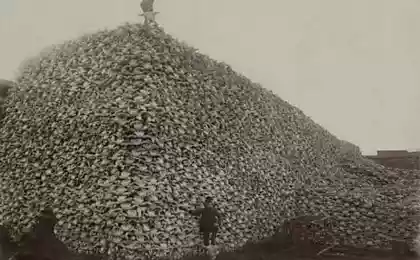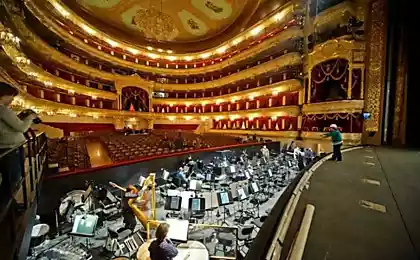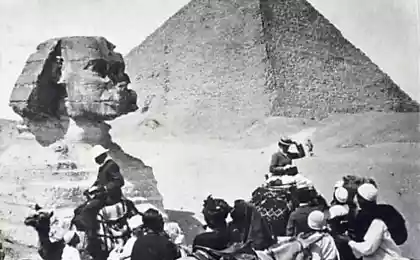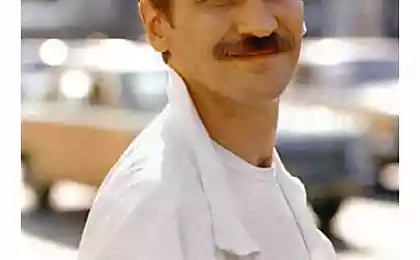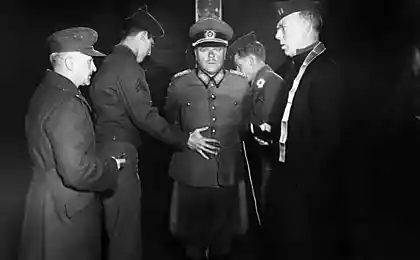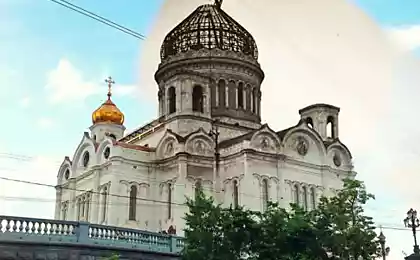2333
World - Pacific Theater of Operations (45 photos)
Since the end of 1942 and early 1945, Allied troops were fighting with Japan in the vast expanses of the Pacific Ocean and on the coasts of small islands. By the end of 1942, the Empire of Japan to maximize their possessions. Japanese soldiers occupied the area from India to Alaska and occupied the island in the South Pacific.
Instead of a direct attack on the Imperial Japanese Navy, US Navy under Admiral Chester Nimitz applied the strategy of "island-hopping". Before the Navy goal was to seize and take control of the strategically important island, located on the way to Japan. On the sea, Japanese submarines, bombers and kamikaze caused much damage the US Navy, but they could not hold back the advance of American troops from island to island. By early 1945, the US Army captured the island of Iwo Jima and Okinawa, which is 550 kilometers from Japan.
Both sides suffered heavy losses. Only in Okinawa for 82 days of fighting, killing about 100,000 Japanese and 12,510 American soldiers, as well as from 42 to 150 thousand local residents.
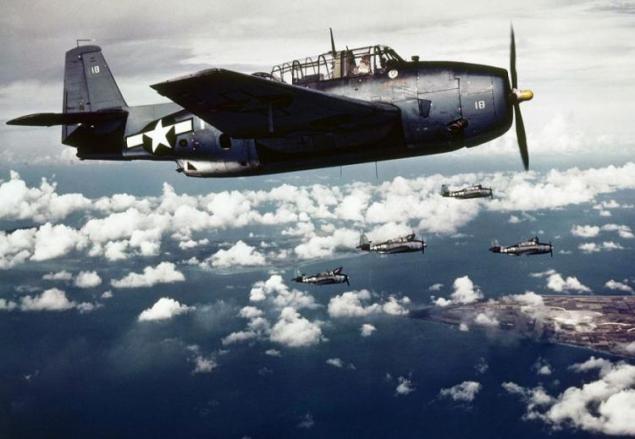
1. American carrier-based planes attacked the Japanese occupied Wake Island, November 1943. (AP Photo)

2. Four Japanese vessel to attack US surface ships and aircraft, burning off Cape Tassafaronga on the island of Guadalcanal, November 16, 1942. Court were part of the higher expression of vehicles and warships to attack the enemy from the north 13 and 14 November. Only these four ships reached Guadalcanal. They were completely destroyed aircraft artillery and surface ships. (AP Photo)
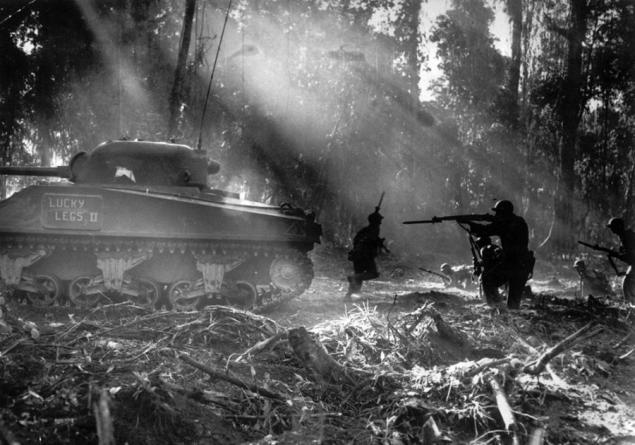
3. The US Marines inspect the territory of the island of Bougainville in the Solomon Islands archipelago under cover of the tank, after the Japanese soldiers entered the night in their rear, in March 1944. (AP Photo)

4. Struck torpedo Japanese destroyer "Yamakadze" was photographed through the periscope of a submarine June 5, 1942. "Yamakadze" sank within 5 minutes after the torpedo hit. All crew members were killed. (AP Photo / U.S. Navy)
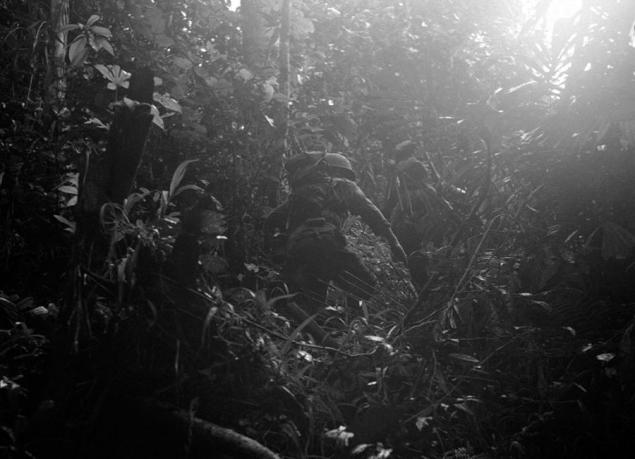
5. American reconnaissance patrol way through the dense jungle of New Guinea, December 18, 1942. (AP Photo / Ed Widdis)

6. Japanese soldiers who died during the attack US Marines in August 1942, lie in the sand near the mortar on the island of Guadalcanal in the Solomon Islands archipelago. (AP Photo)

7. Australian soldier in a helmet with a gun and examines the typical landscape of New Guinea in the vicinity of the Bay of Milne Bay, where Australian soldiers repelled before the Japanese invasion attempt, October 31, 1942. (AP Photo)
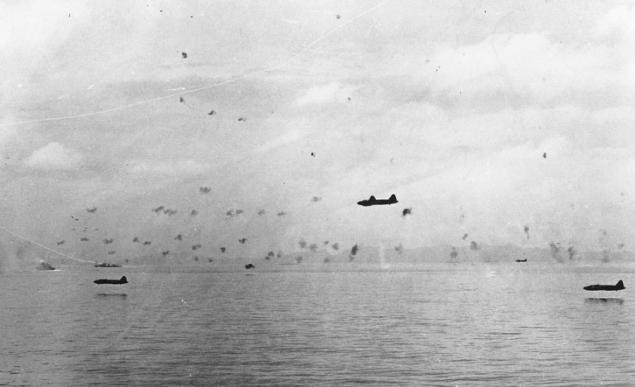
8. Japanese bombers reduced to attack US warships in the Pacific Ocean, 25 September 1942. (AP Photo)
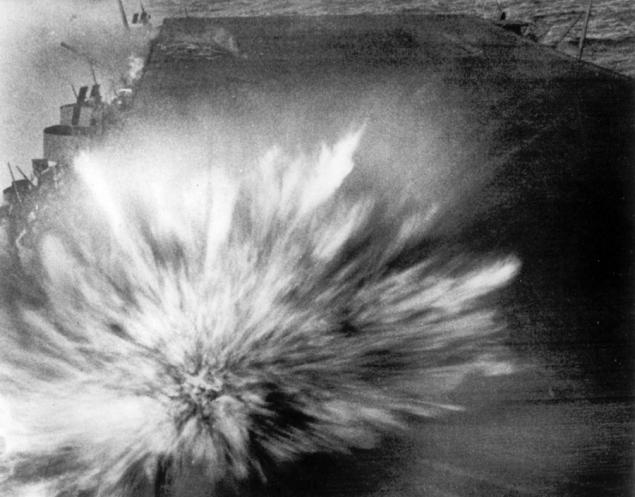
9. August 24, 1942 the USS "Enterprise", is located near the Solomon Islands, was attacked by Japanese bombers. As a result, several direct hits of projectiles in flight deck killed 74 people. Among the dead was also a photographer, took this picture. (AP Photo)
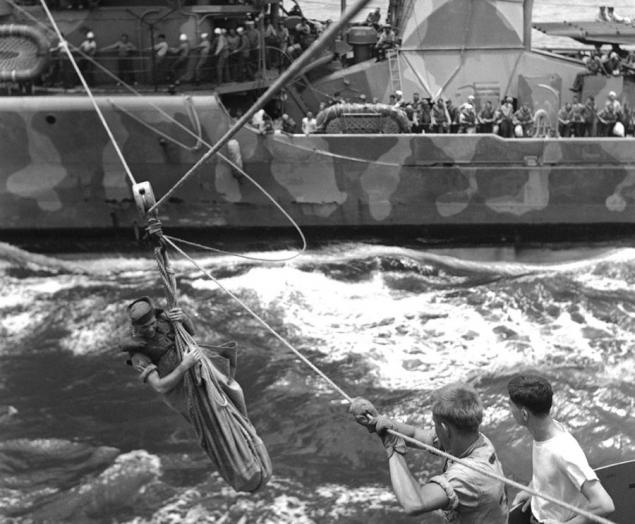
10. Military personnel are evacuated from aboard the USS cruiser in the rescue cradle, November 14, 1942. The destroyer was sunk during naval operations against Japan off the coast of Santa Cruz Islands in the South Pacific, October 26th. US Navy won the battle against the Japanese, but lost an aircraft carrier and a destroyer. (AP Photo)
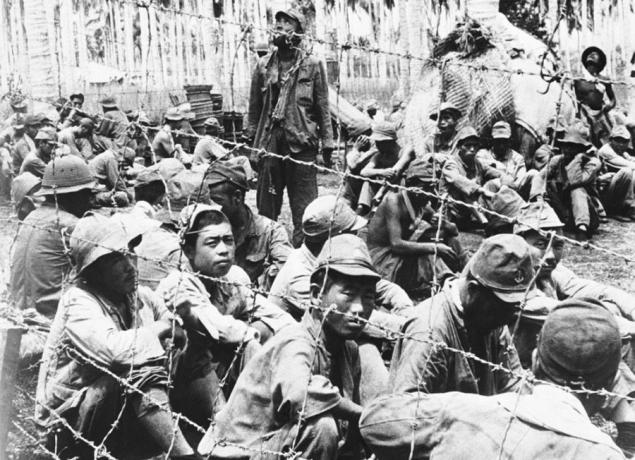
11. In the photo: Japanese prisoners of war, collared on Guadalcanal in the Solomon Islands archipelago, Nov. 5, 1942. (AP Photo)
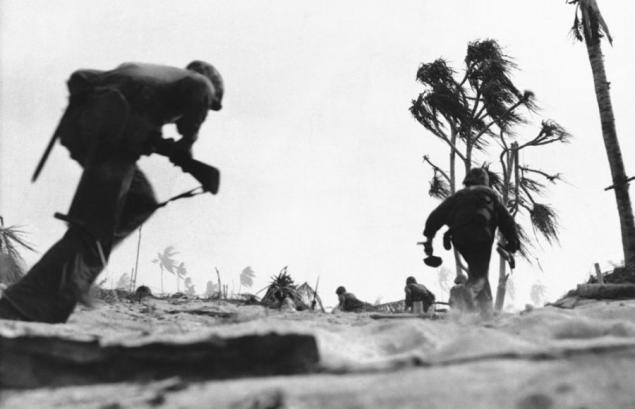
12. US Marines sneak along the beach on the island of Tarawa during the attack on the Japanese airport, 2 December 1943. (AP Photo)
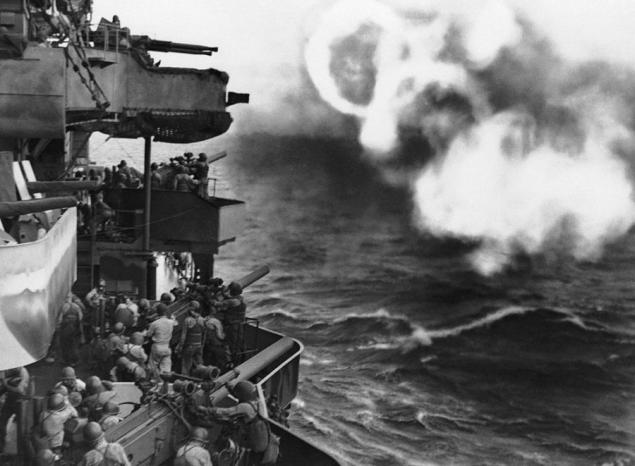
13. American cruiser bombed Japan's position on Mackinac Island, which is included in the Gilbert Islands, before landing of American troops on the atoll, 20 November 1943. (AP Photo)
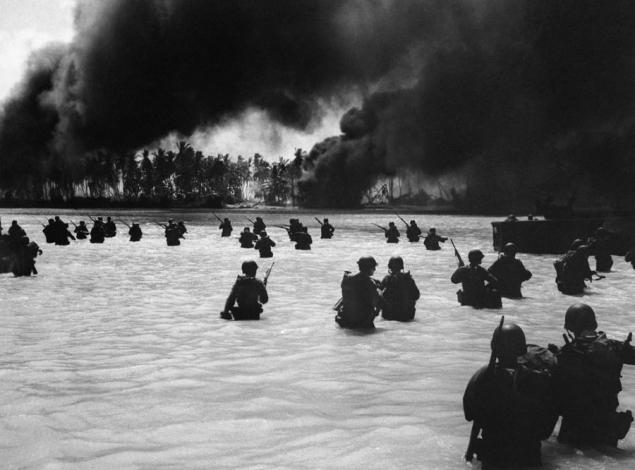
14. Soldiers 165th Infantry Regiment landed on the shore of the island Butaritari, which is part of the atoll Makin, who had previously been bombed with warships, November 20, 1943. American soldiers retook the Japanese Atoll, part of a group of islands Gilbert. (AP Photo)
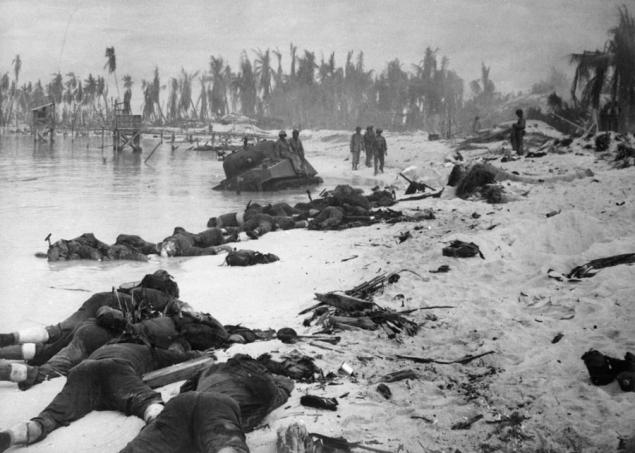
15. The bodies of American soldiers lie on the beach one of the islands of Tarawa atoll after a fierce battle during the US invasion in the Gilbert Islands in late November 1943. As a result, the three-day Battle of Tarawa killed about a thousand Marines. More 687 sailors died on the US Navy aircraft carrier «USS Liscome Bay», which was sunk by a Japanese torpedo. (AP Photo)
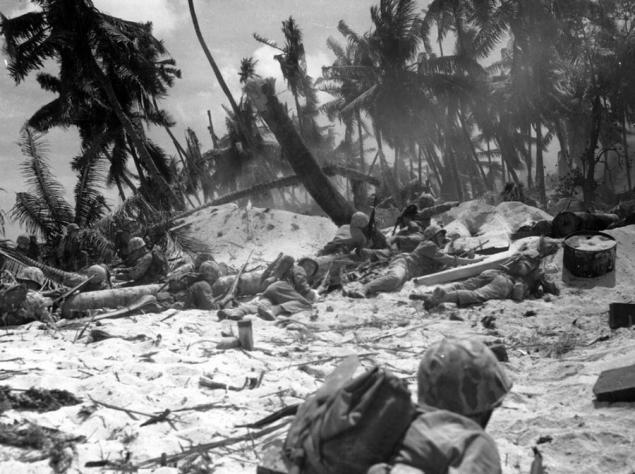
16. US Marines are moving in the direction of the Japanese positions during the assault on Tarawa Atoll, which is part of the Gilbert Islands, the end of November 1943. From 5000 Japanese soldiers and workers who were on the island, were captured only 146 people. All the rest were killed. (AP Photo)

17. Marines waiting for the order to the pursuit of the retreating Japanese troops on the island of Vella Lavella, Solomon Islands, 13 September 1943. (U.S. Army)

18. In the photo: two of the twelve US light bombers «A-20 Havoc», took part in the raid on the caucus, Indonesia, in July 1943. One of the bombers was shot down by anti-aircraft fire and crashed into the sea. Both crew members were killed. (USAF)
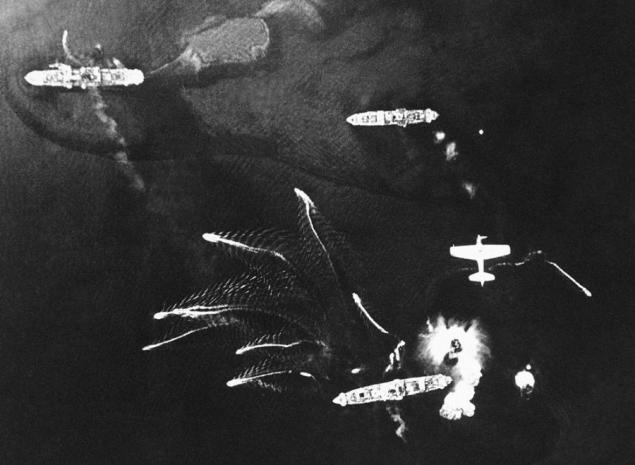
19. The small Japanese vessel leave the larger ships during a raid by US aircraft harbor Tonolei, Japanese base on the island of Bougainville in the Solomon Islands archipelago, October 9, 1943. (AP Photo / U.S. Navy)
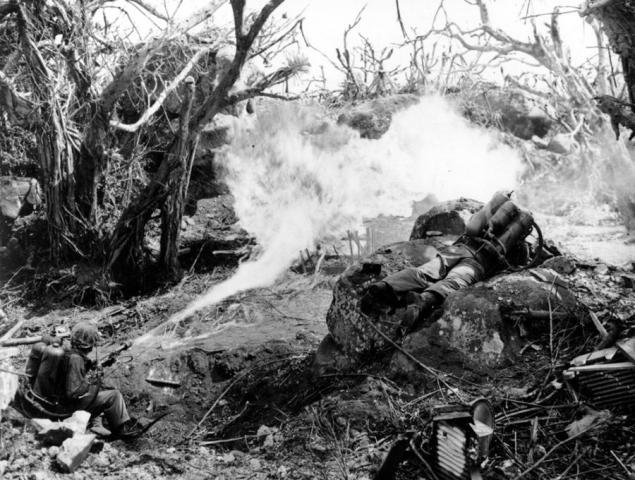
20. US Marines shoot flamethrowers on the Japanese fortifications, blocks the way to Mount Suribachi on the island of Iwo Jima, March 4, 1945. On the left is an ordinary Richard Klattiz from North Fond Dulac, Wisconsin, and the right - Private 1st Class Wilfred Vougli. (AP Photo / U.S. Marine Corps)

21. United States Marine found this Japanese family who hid in a cave on a hillside on the island of Saipan, making bypassing, June 21, 1944. Mother, four children and a dog took refuge in the cave, when the region of fierce fighting during the US invasion in the Mariana Islands. (AP Photo)
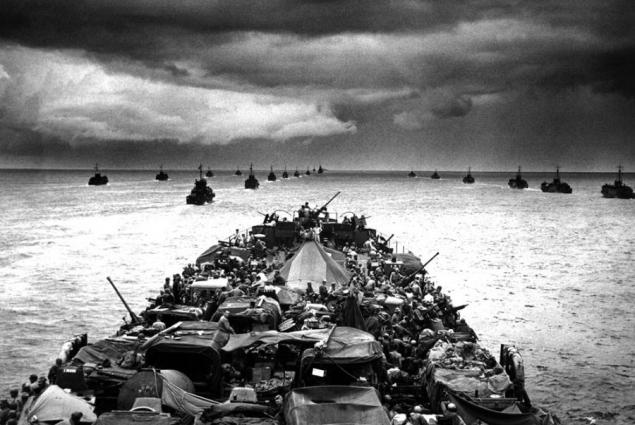
22. Columns of small landing craft LCI with soldiers on board follow the large landing ship on the way to Cape Sansapor in New Guinea, 1944. (Photographer's Mate, 1st Cl. Harry R. Watson / US Coast Guard)
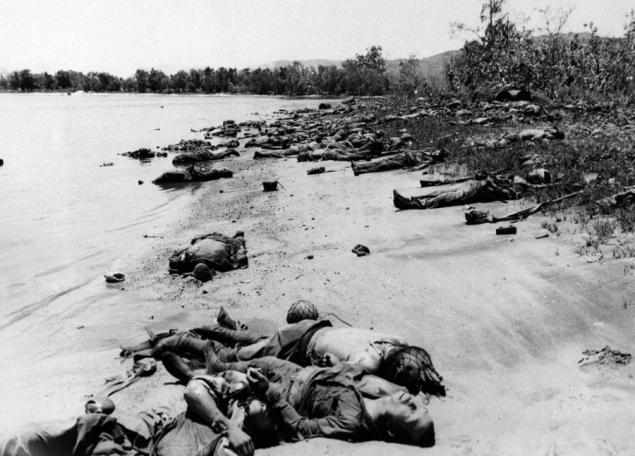
23. The bodies of Japanese soldiers who died in a desperate battle with US Marines, lie on the beach near the settlement on the island of Saipan Tanapag in the archipelago of the Mariana Islands, July 14, 1944. During the attack on the Japanese stronghold Marines killed about 1,300 Japanese. (AP Photo)
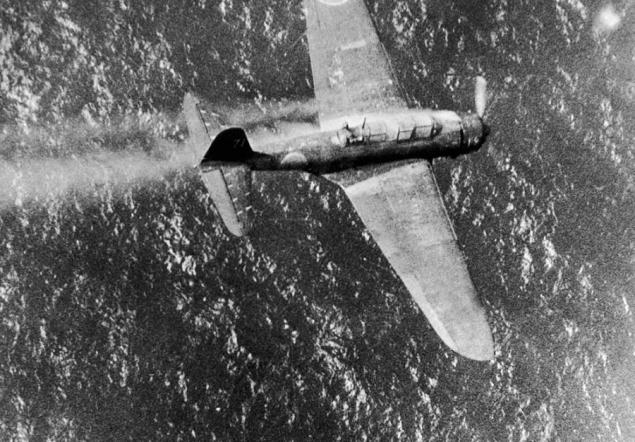
24. Japanese dive bomber, shot down near the Japanese stronghold of Truk plane «Navy PB4Y», falls into the sea, 2 July 1944. American aircraft pilot, Lieutenant Commander William Janeshek, said that the gunner aboard a bomber behaved as if he were about to jump with a parachute, but then suddenly stopped and sat motionless until the plane fell into the water and did not explode. (AP Photo / U.S. Navy)

25. amphibious tracked amphibious cars heading towards the fortifications on the strategically important island of Peleliu, 15 September 1944. Amphibious tanks equipped with guns went to storm the island after the bombing from the sea and from the air. (AP Photo)
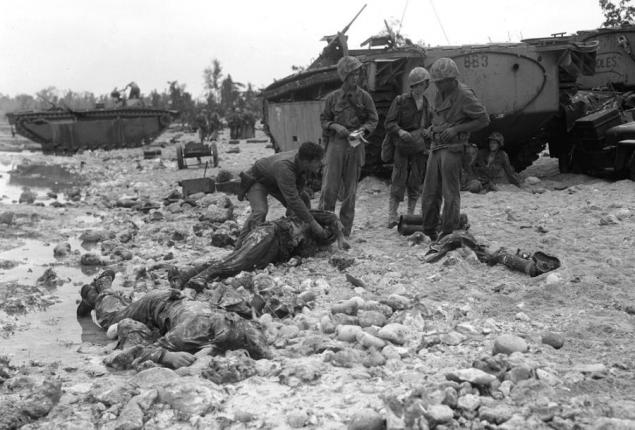
26. Soldiers of the 1st Marine Division stand near the bodies of their comrades who were killed by Japanese soldiers on the beach of the island Peleliu, Republic of Palau, in September 1944. At the end of the campaign 10,695 of 11,000 stationed on the island soldiers were killed and only about 200 captured. (AP Photo / Joe Rosenthal / Pool)
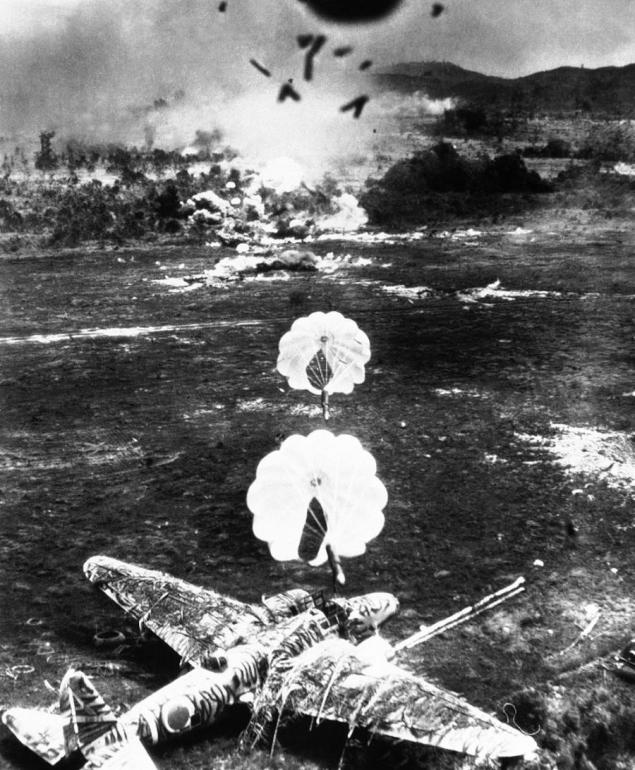
27. The fragmentation bombs fall on Japanese bomber disguised Mitsubishi Ki-21 "Sally" during the attack on the US Air Force Airport «Old Namlea» on the island of Buru, Dutch East Indies, October 15, 1944. (AP Photo)
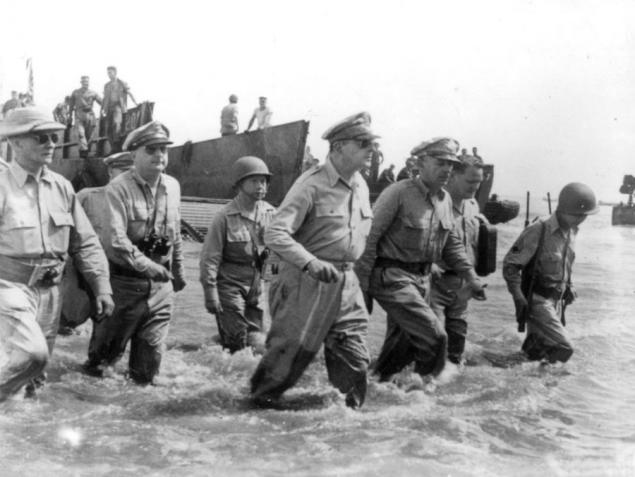
28. General Douglas MacArthur (center) is sent to the bank, accompanied by his officers and Sergio Osmena, President of the Philippines in exile (left), during a landing operation on the island of Leyte, Philippines, October 20, 1944. American troops occupied the coast of the island occupied by the Japanese. (AP Photo / U.S. Army)

29. The bodies of Japanese soldiers lying on the hillside. They were shot and killed by US forces when attempting a desperate attack on the ridge in Guam, 1944. (AP Photo / Joe Rosenthal)

30. Sudden attack of the 14th Air Army US Hong Kong harbor, October 16, 1944. Smoke rising from burning Kowloon docks and a nearby railway. Japanese bomber (left of center) climbs to attack US aircraft. (AP Photo)
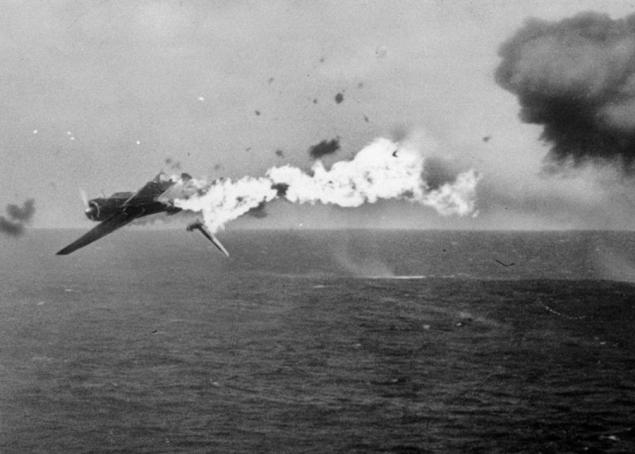
31. Burning Japanese torpedo bomber crashes as a result of direct exposure to 5-inch shells fired aircraft carrier "Yorktown", October 25, 1944. (AP Photo / U.S. Navy)
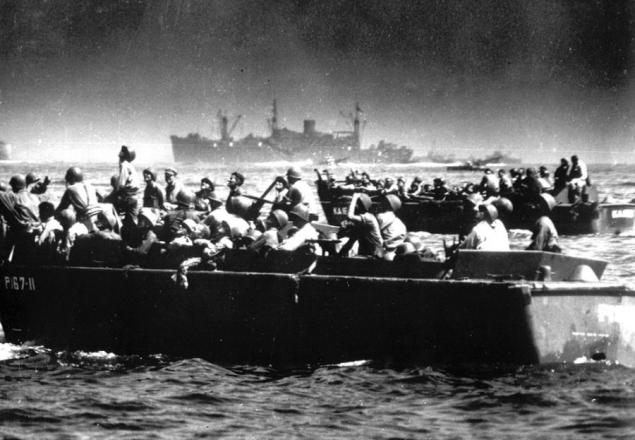
32. Barges with American soldiers sent to the shores of the island of Leyte in October 1944. Soldiers watch the air battle of the American and Japanese aircraft in the sky above their heads. (AP Photo)

33. In the picture provided by the former kamikaze pilot Toshio Yoshitake, sealed Yoshitake (right) and his colleagues (from left to right) Tetsuya Ueno, Koshiro Hayashi Naoki Takao Oh Okaga and against the background of a fighter «Zero» before departing from the airport to the east of the Imperial Army Tokyo, November 8, 1944. Of the 17 pilots and flight instructors, escaping the day survived only Yoshitake. He was forced to make an emergency landing when his wounded in the sky American warplane. (AP Photo)
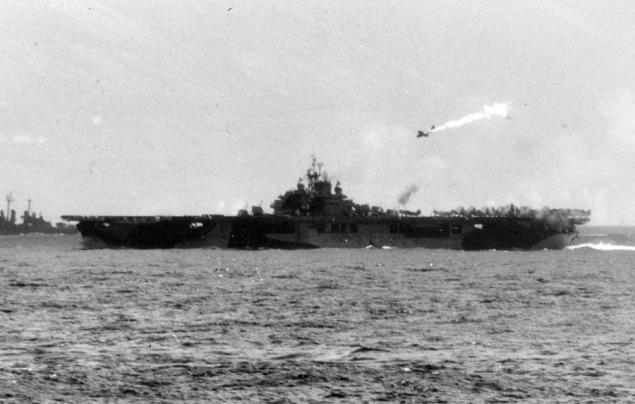
34. Japanese kamikaze directs damaged single-engine bomber in the US aircraft carrier "Essex" near the Philippine Islands, 25 November 1944. (U.S. Navy)
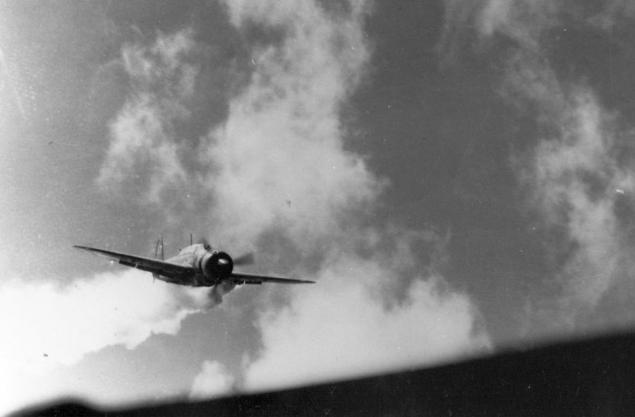
35. The smoking Japanese aircraft, piloted by suicide bombers, was photographed a few seconds before falling to the deck of an aircraft carrier "Essex", 25 November 1944. (U.S. Navy)
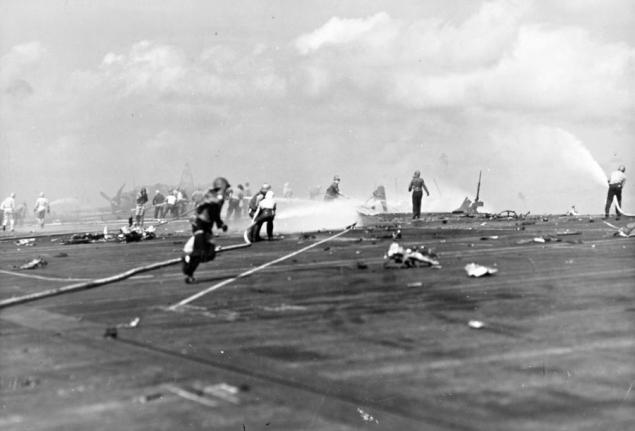
36. Consequences of a kamikaze attack on an aircraft carrier "Essex" in November 1944. Firefighters extinguish a fire on the deck strewn with wreckage. Bomber crashed into the flight deck of an aircraft carrier at the left side near the aircraft, which were tucked before departure. 15 people died and 44 were injured. (U.S. Navy)
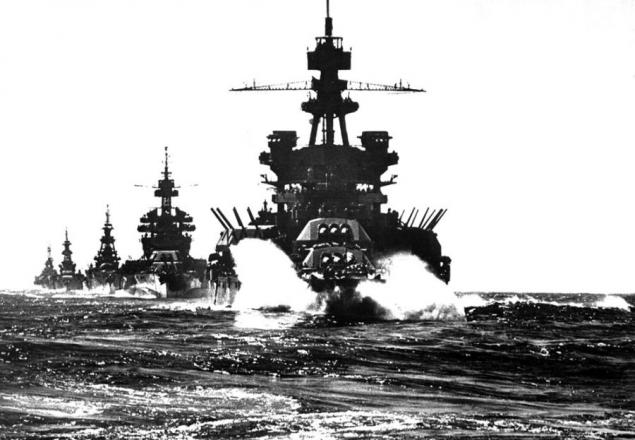
37. Battleship "Pennsylvania" is sent to the Lingayen Gulf, accompanied by three cruisers to land troops on the island of Luzon, the Philippines, in January 1945. (U.S. Navy)
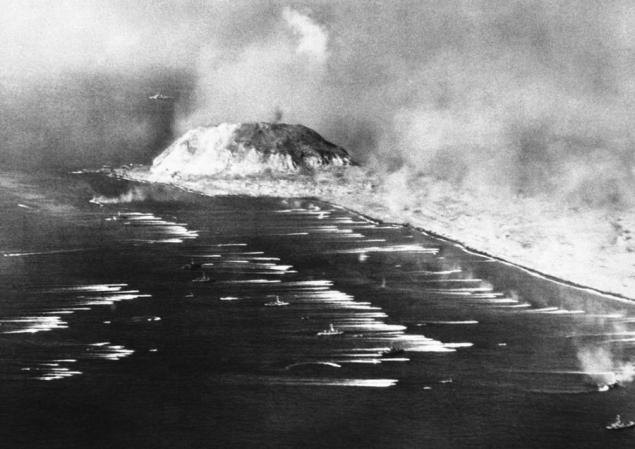
38. US Marines sent to the shores of Iwo Jima, the Japanese islands occupied by 19 February 1945. The photograph was taken by photographer who flew over an armada of Navy and Coast Guard vessels in the search aircraft of the Navy. (AP Photo)
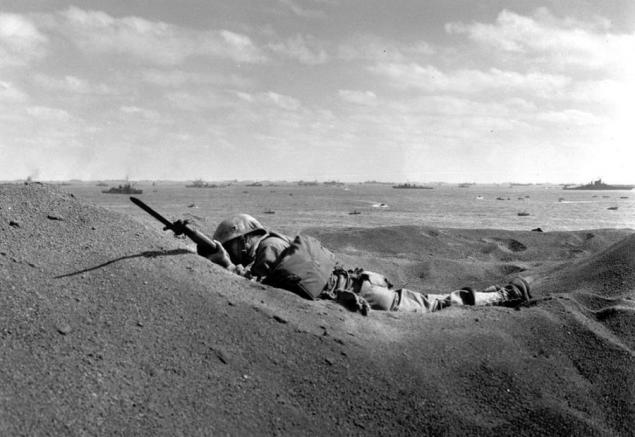
39. US Marine shot by a Japanese sniper, lay with arms on the black volcanic sand of Iwo Jima, February 19, 1945. In the background one can see the battleships of the US Navy. (AP Photo)

40. US Marines of the 28th Regiment, 5th Division set an American flag on Mount Suribachi, Iwo Jima island, 23 February 1945. Battle of Iwo Jima was the bloodiest in the history of the Marine Corps: 36 days of fighting killed nearly 7,000 US soldiers. (AP Photo / Joe Rosenthal)
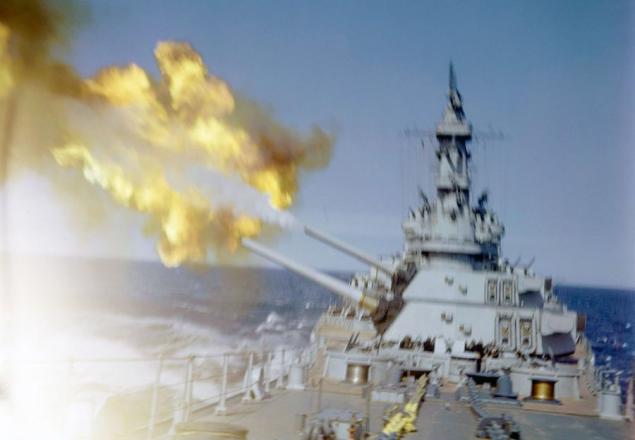
41. The US cruiser firing on Japanese positions on the southern tip of the island of Okinawa, Japan, in 1945. (AP Photo)

42. US troops lay a beachhead on the island of Okinawa, 560 miles from the islands of Japan, April 13, 1945. Amphibious ships, supplying food and military equipment, dot the sea to the horizon. In the distance the warships of the US Navy. (AP Photo / U.S. Coast Guard)
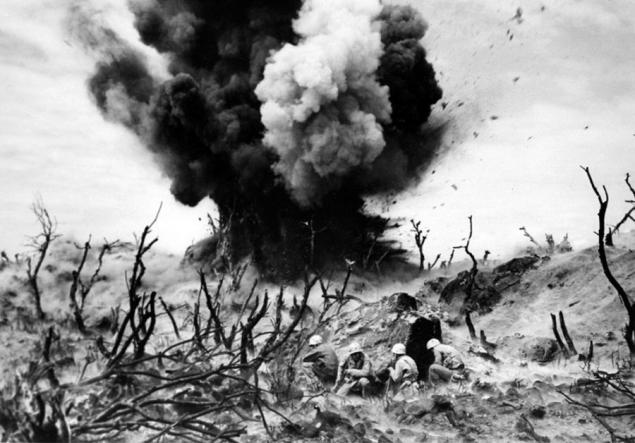
43. US Marines attack on one of the caves leading to the three-tier checkpoint, on the island of Iwo Jima, April 2, 1945. (AP Photo / W. Eugene Smith)
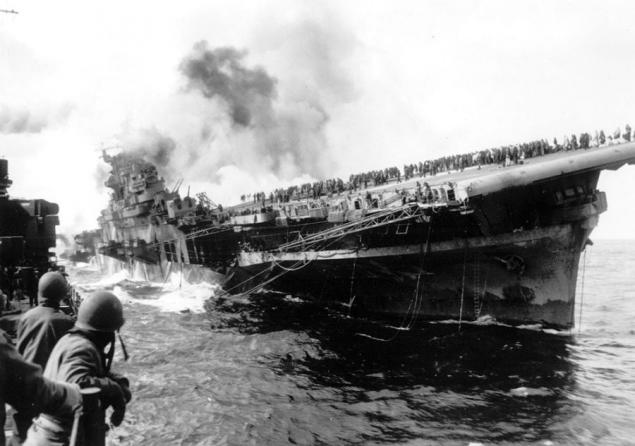
44. USS «Santa Fe» stands next to a damaged aircraft carrier «Franklin». The aircraft carrier was attacked by Japanese bombers during the Battle of Okinawa islands off the coast of Honshu, Japan, March 19, 1945. More than 800 people died, and the surviving members of the crew tried to put out the fire and repair the ship to prevent it from sinking. (AP Photo)
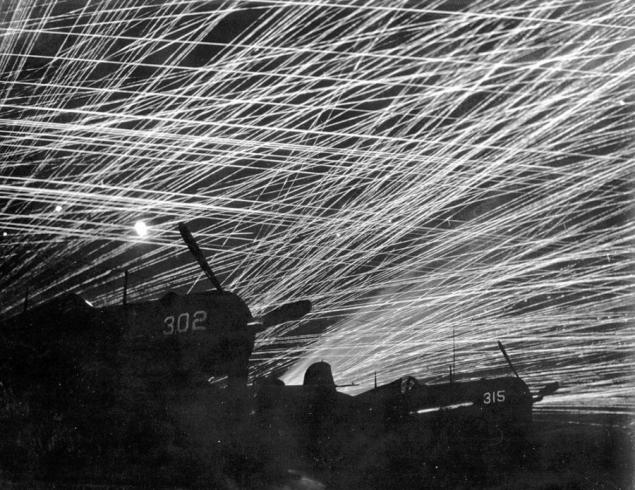
45. Silhouettes of aircraft squadrons Marine Corps «Hell's Belles» are seen against the sky, filled with the fire of anti-aircraft shells, during an air raid Japanese aircraft on the airfield «Yonton» in Okinawa, Japan, April 28, 1945. (AP Photo / U.S. Marine Corps)
Instead of a direct attack on the Imperial Japanese Navy, US Navy under Admiral Chester Nimitz applied the strategy of "island-hopping". Before the Navy goal was to seize and take control of the strategically important island, located on the way to Japan. On the sea, Japanese submarines, bombers and kamikaze caused much damage the US Navy, but they could not hold back the advance of American troops from island to island. By early 1945, the US Army captured the island of Iwo Jima and Okinawa, which is 550 kilometers from Japan.
Both sides suffered heavy losses. Only in Okinawa for 82 days of fighting, killing about 100,000 Japanese and 12,510 American soldiers, as well as from 42 to 150 thousand local residents.

1. American carrier-based planes attacked the Japanese occupied Wake Island, November 1943. (AP Photo)

2. Four Japanese vessel to attack US surface ships and aircraft, burning off Cape Tassafaronga on the island of Guadalcanal, November 16, 1942. Court were part of the higher expression of vehicles and warships to attack the enemy from the north 13 and 14 November. Only these four ships reached Guadalcanal. They were completely destroyed aircraft artillery and surface ships. (AP Photo)

3. The US Marines inspect the territory of the island of Bougainville in the Solomon Islands archipelago under cover of the tank, after the Japanese soldiers entered the night in their rear, in March 1944. (AP Photo)

4. Struck torpedo Japanese destroyer "Yamakadze" was photographed through the periscope of a submarine June 5, 1942. "Yamakadze" sank within 5 minutes after the torpedo hit. All crew members were killed. (AP Photo / U.S. Navy)

5. American reconnaissance patrol way through the dense jungle of New Guinea, December 18, 1942. (AP Photo / Ed Widdis)

6. Japanese soldiers who died during the attack US Marines in August 1942, lie in the sand near the mortar on the island of Guadalcanal in the Solomon Islands archipelago. (AP Photo)

7. Australian soldier in a helmet with a gun and examines the typical landscape of New Guinea in the vicinity of the Bay of Milne Bay, where Australian soldiers repelled before the Japanese invasion attempt, October 31, 1942. (AP Photo)

8. Japanese bombers reduced to attack US warships in the Pacific Ocean, 25 September 1942. (AP Photo)

9. August 24, 1942 the USS "Enterprise", is located near the Solomon Islands, was attacked by Japanese bombers. As a result, several direct hits of projectiles in flight deck killed 74 people. Among the dead was also a photographer, took this picture. (AP Photo)

10. Military personnel are evacuated from aboard the USS cruiser in the rescue cradle, November 14, 1942. The destroyer was sunk during naval operations against Japan off the coast of Santa Cruz Islands in the South Pacific, October 26th. US Navy won the battle against the Japanese, but lost an aircraft carrier and a destroyer. (AP Photo)

11. In the photo: Japanese prisoners of war, collared on Guadalcanal in the Solomon Islands archipelago, Nov. 5, 1942. (AP Photo)

12. US Marines sneak along the beach on the island of Tarawa during the attack on the Japanese airport, 2 December 1943. (AP Photo)

13. American cruiser bombed Japan's position on Mackinac Island, which is included in the Gilbert Islands, before landing of American troops on the atoll, 20 November 1943. (AP Photo)

14. Soldiers 165th Infantry Regiment landed on the shore of the island Butaritari, which is part of the atoll Makin, who had previously been bombed with warships, November 20, 1943. American soldiers retook the Japanese Atoll, part of a group of islands Gilbert. (AP Photo)

15. The bodies of American soldiers lie on the beach one of the islands of Tarawa atoll after a fierce battle during the US invasion in the Gilbert Islands in late November 1943. As a result, the three-day Battle of Tarawa killed about a thousand Marines. More 687 sailors died on the US Navy aircraft carrier «USS Liscome Bay», which was sunk by a Japanese torpedo. (AP Photo)

16. US Marines are moving in the direction of the Japanese positions during the assault on Tarawa Atoll, which is part of the Gilbert Islands, the end of November 1943. From 5000 Japanese soldiers and workers who were on the island, were captured only 146 people. All the rest were killed. (AP Photo)

17. Marines waiting for the order to the pursuit of the retreating Japanese troops on the island of Vella Lavella, Solomon Islands, 13 September 1943. (U.S. Army)

18. In the photo: two of the twelve US light bombers «A-20 Havoc», took part in the raid on the caucus, Indonesia, in July 1943. One of the bombers was shot down by anti-aircraft fire and crashed into the sea. Both crew members were killed. (USAF)

19. The small Japanese vessel leave the larger ships during a raid by US aircraft harbor Tonolei, Japanese base on the island of Bougainville in the Solomon Islands archipelago, October 9, 1943. (AP Photo / U.S. Navy)

20. US Marines shoot flamethrowers on the Japanese fortifications, blocks the way to Mount Suribachi on the island of Iwo Jima, March 4, 1945. On the left is an ordinary Richard Klattiz from North Fond Dulac, Wisconsin, and the right - Private 1st Class Wilfred Vougli. (AP Photo / U.S. Marine Corps)

21. United States Marine found this Japanese family who hid in a cave on a hillside on the island of Saipan, making bypassing, June 21, 1944. Mother, four children and a dog took refuge in the cave, when the region of fierce fighting during the US invasion in the Mariana Islands. (AP Photo)

22. Columns of small landing craft LCI with soldiers on board follow the large landing ship on the way to Cape Sansapor in New Guinea, 1944. (Photographer's Mate, 1st Cl. Harry R. Watson / US Coast Guard)

23. The bodies of Japanese soldiers who died in a desperate battle with US Marines, lie on the beach near the settlement on the island of Saipan Tanapag in the archipelago of the Mariana Islands, July 14, 1944. During the attack on the Japanese stronghold Marines killed about 1,300 Japanese. (AP Photo)

24. Japanese dive bomber, shot down near the Japanese stronghold of Truk plane «Navy PB4Y», falls into the sea, 2 July 1944. American aircraft pilot, Lieutenant Commander William Janeshek, said that the gunner aboard a bomber behaved as if he were about to jump with a parachute, but then suddenly stopped and sat motionless until the plane fell into the water and did not explode. (AP Photo / U.S. Navy)

25. amphibious tracked amphibious cars heading towards the fortifications on the strategically important island of Peleliu, 15 September 1944. Amphibious tanks equipped with guns went to storm the island after the bombing from the sea and from the air. (AP Photo)

26. Soldiers of the 1st Marine Division stand near the bodies of their comrades who were killed by Japanese soldiers on the beach of the island Peleliu, Republic of Palau, in September 1944. At the end of the campaign 10,695 of 11,000 stationed on the island soldiers were killed and only about 200 captured. (AP Photo / Joe Rosenthal / Pool)

27. The fragmentation bombs fall on Japanese bomber disguised Mitsubishi Ki-21 "Sally" during the attack on the US Air Force Airport «Old Namlea» on the island of Buru, Dutch East Indies, October 15, 1944. (AP Photo)

28. General Douglas MacArthur (center) is sent to the bank, accompanied by his officers and Sergio Osmena, President of the Philippines in exile (left), during a landing operation on the island of Leyte, Philippines, October 20, 1944. American troops occupied the coast of the island occupied by the Japanese. (AP Photo / U.S. Army)

29. The bodies of Japanese soldiers lying on the hillside. They were shot and killed by US forces when attempting a desperate attack on the ridge in Guam, 1944. (AP Photo / Joe Rosenthal)

30. Sudden attack of the 14th Air Army US Hong Kong harbor, October 16, 1944. Smoke rising from burning Kowloon docks and a nearby railway. Japanese bomber (left of center) climbs to attack US aircraft. (AP Photo)

31. Burning Japanese torpedo bomber crashes as a result of direct exposure to 5-inch shells fired aircraft carrier "Yorktown", October 25, 1944. (AP Photo / U.S. Navy)

32. Barges with American soldiers sent to the shores of the island of Leyte in October 1944. Soldiers watch the air battle of the American and Japanese aircraft in the sky above their heads. (AP Photo)

33. In the picture provided by the former kamikaze pilot Toshio Yoshitake, sealed Yoshitake (right) and his colleagues (from left to right) Tetsuya Ueno, Koshiro Hayashi Naoki Takao Oh Okaga and against the background of a fighter «Zero» before departing from the airport to the east of the Imperial Army Tokyo, November 8, 1944. Of the 17 pilots and flight instructors, escaping the day survived only Yoshitake. He was forced to make an emergency landing when his wounded in the sky American warplane. (AP Photo)

34. Japanese kamikaze directs damaged single-engine bomber in the US aircraft carrier "Essex" near the Philippine Islands, 25 November 1944. (U.S. Navy)

35. The smoking Japanese aircraft, piloted by suicide bombers, was photographed a few seconds before falling to the deck of an aircraft carrier "Essex", 25 November 1944. (U.S. Navy)

36. Consequences of a kamikaze attack on an aircraft carrier "Essex" in November 1944. Firefighters extinguish a fire on the deck strewn with wreckage. Bomber crashed into the flight deck of an aircraft carrier at the left side near the aircraft, which were tucked before departure. 15 people died and 44 were injured. (U.S. Navy)

37. Battleship "Pennsylvania" is sent to the Lingayen Gulf, accompanied by three cruisers to land troops on the island of Luzon, the Philippines, in January 1945. (U.S. Navy)

38. US Marines sent to the shores of Iwo Jima, the Japanese islands occupied by 19 February 1945. The photograph was taken by photographer who flew over an armada of Navy and Coast Guard vessels in the search aircraft of the Navy. (AP Photo)

39. US Marine shot by a Japanese sniper, lay with arms on the black volcanic sand of Iwo Jima, February 19, 1945. In the background one can see the battleships of the US Navy. (AP Photo)

40. US Marines of the 28th Regiment, 5th Division set an American flag on Mount Suribachi, Iwo Jima island, 23 February 1945. Battle of Iwo Jima was the bloodiest in the history of the Marine Corps: 36 days of fighting killed nearly 7,000 US soldiers. (AP Photo / Joe Rosenthal)

41. The US cruiser firing on Japanese positions on the southern tip of the island of Okinawa, Japan, in 1945. (AP Photo)

42. US troops lay a beachhead on the island of Okinawa, 560 miles from the islands of Japan, April 13, 1945. Amphibious ships, supplying food and military equipment, dot the sea to the horizon. In the distance the warships of the US Navy. (AP Photo / U.S. Coast Guard)

43. US Marines attack on one of the caves leading to the three-tier checkpoint, on the island of Iwo Jima, April 2, 1945. (AP Photo / W. Eugene Smith)

44. USS «Santa Fe» stands next to a damaged aircraft carrier «Franklin». The aircraft carrier was attacked by Japanese bombers during the Battle of Okinawa islands off the coast of Honshu, Japan, March 19, 1945. More than 800 people died, and the surviving members of the crew tried to put out the fire and repair the ship to prevent it from sinking. (AP Photo)

45. Silhouettes of aircraft squadrons Marine Corps «Hell's Belles» are seen against the sky, filled with the fire of anti-aircraft shells, during an air raid Japanese aircraft on the airfield «Yonton» in Okinawa, Japan, April 28, 1945. (AP Photo / U.S. Marine Corps)












